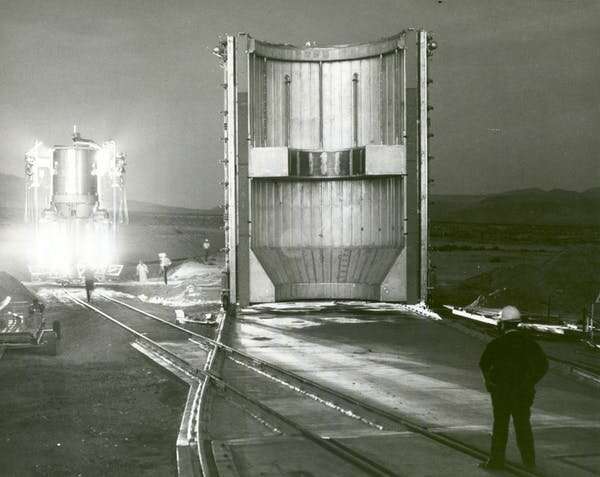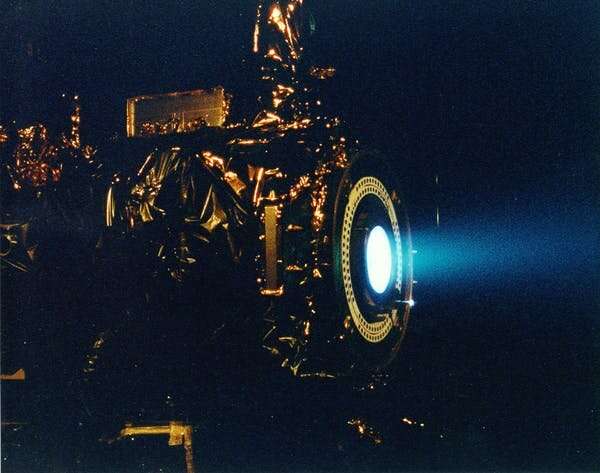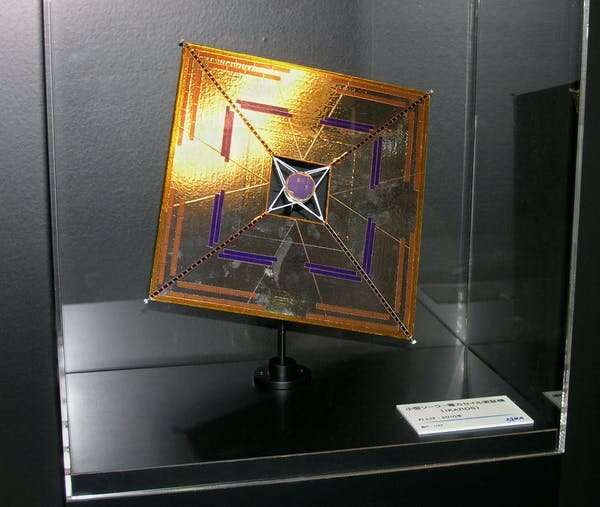There are many other variables which ultimately also determine the efficiency of a rocket engine, and scientists and engineers are always looking to get more thrust and fuel efficiency out of a given design.
Recently, private company SpaceX has been conducting test flights of their Starship launcher prototype. This vehicle uses a "full-flow staged combustion (FFSC) engine," the Raptor, which burns methane for fuel and oxygen for oxidiser. Such designs were tested by the Russians in the 1960s and the US government in the 2000s, but as yet none has flown in space. The engines are much more fuel efficient and can generate a much higher thrust-to-weight ratio than traditional designs.

Fission thermal rockets
The nucleus of an atom consists of sub-atomic particles called protons and neutrons. These determine the mass of an element—the more protons and neutrons, the heavier it is. Some atomic nuclei are unstable and can be split into several smaller nuclei when bombarded with neutrons. This is the process of nuclear fission, and it can release an enormous amount of energy. As the nuclei decay, they also release more neutrons which go on to fissure more atoms—producing a chain reaction.
In a nuclear fission thermal rocket, a propellant gas, such as hydrogen, is heated by nuclear fission to high temperatures, creating a high pressure gas within the reactor chamber. Like with chemical rockets, this can only escape via the rocket nozzle, again producing thrust. Nuclear fission rockets are not envisaged to produce the kind of thrust necessary to lift large payloads from the surface of the Earth into space. Once in space though, they are much more efficient than chemical rockets—for a given mass of propellant, they can accelerate a spacecraft to much higher speeds.
Nuclear fission rockets have never been flown in space, but they have been tested on the ground. They should be able to shorten flight times between Earth and Mars from some seven months to about three months for future crewed missions. Obvious drawbacks, however, include the production of radioactive waste, and the possibility of a launch failure which could result in radioactive material being spread over a wide area.
A major engineering challenge is to sufficiently miniaturize a reactor so that it will fit on a spacecraft. There is already a burgeoning industry in the production of compact fission reactors, including the development of a fission reactor which is smaller than an adult human.

Electric propulsion
A staple of science fiction, real ion drives generate charged particles (ionization), accelerate them using electric fields and then fire them from a thruster. The propellant is a gas such as xenon, a fairly heavy element that can be easily electrically charged.
As the charged xenon atoms accelerate out of the thruster, they transfer a very small amount of momentum (the product of mass and velocity) to the spacecraft, providing gentle thrust. While slow, ion drives are among the most fuel-efficient of all spacecraft propulsion methods, so could get us further. Ion drives are commonly used for attitude control (changing which direction a spacecraft is facing) and have been considered for deorbiting old satellites.
Current ion engines are powered by solar cells, effectively making them solar powered, and requiring very little propellant. They have been used on Esa's SMART-1 mission to the Moon and Bepi-Colombo mission en-route to Mercury. Nasa are currently developing a high power electric propulsion system for the Lunar Gateway, an outpost which will orbit the Moon.
Solar sails
While propulsion usually requires propellant of some description, a more "green" method relying only on light from the Sun itself.

Sails rely on the physical property of conservation of momentum. On Earth, we are used to seeing this momentum as a dynamic pressure from air particles blowing into a sheet when sailing, propelling a vessel forwards. Light is comprised of photons, which have no mass, but they do have momentum and can transfer it to a sail. As the energies of individual photons are very small, an extremely large sail size is needed for any appreciable acceleration.
The speed gain will also depend on how far from the Sun you are. At Earth, the power received from sunlight is about 1.3 kW per square meter. If we had a sail the size of a football pitch, this would equate to 9.3 MW, providing a very low acceleration, even to a low mass object.
Solar sails have been tested by the Japanese IKAROS spacecraft which successfully flew by Venus, and the Planetary Society Lightsail-2, which is presently in orbit around Earth.
A way of improving efficiency and reducing sail size is to use a laser to propel the spacecraft forward. Lasers produce very intense beams of photons which can be directed onto a sail to provide much higher acceleration, but would require being built in Earth orbit to avoid loss of intensity in the atmosphere. Lasers have also been proposed as a means of de-orbiting space junk—the light from the laser can slow down a piece of orbital junk, which would then fall out of orbit and burn up in the atmosphere.
The development of nuclear fission rockets may excite some and concern others. However, as private companies and national space agencies are increasingly committing to a sustained human presence in space, these alternative means of propulsion will become more mainstream and have the potential to revolutionize our nascent space-faring civilisation.
Explore further
This article is republished from The Conversation under a Creative Commons license. Read the original article.![]()



